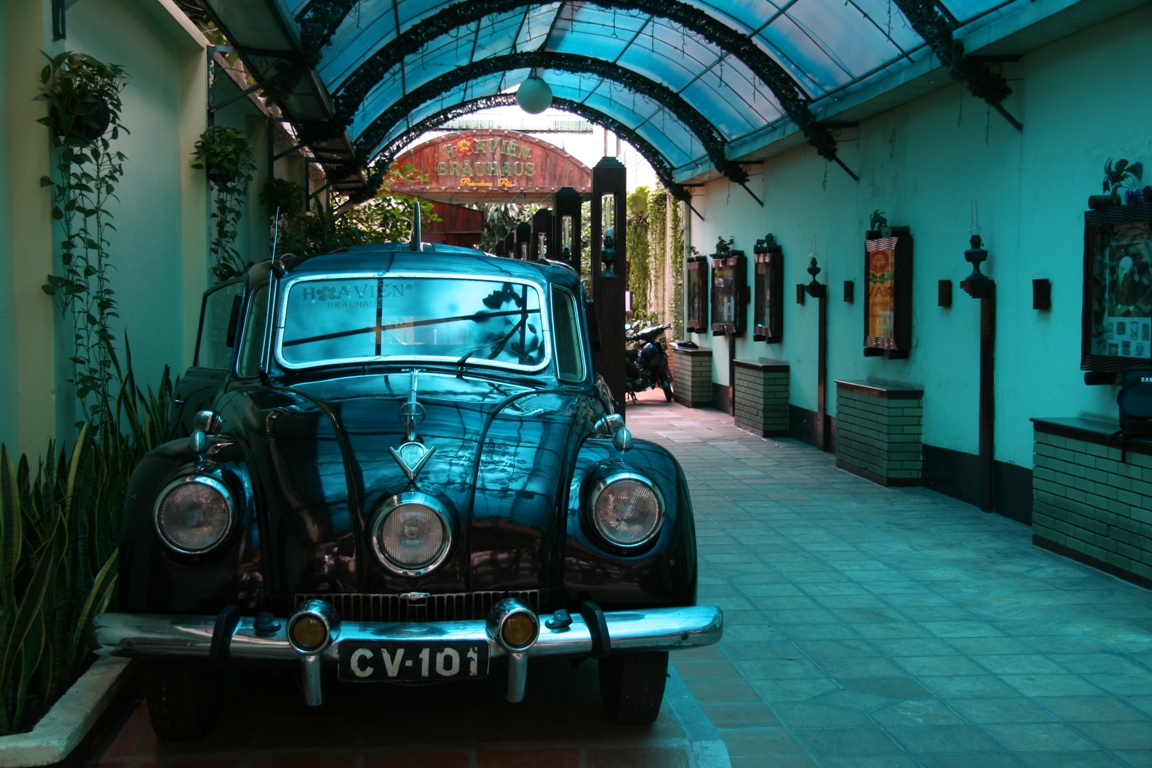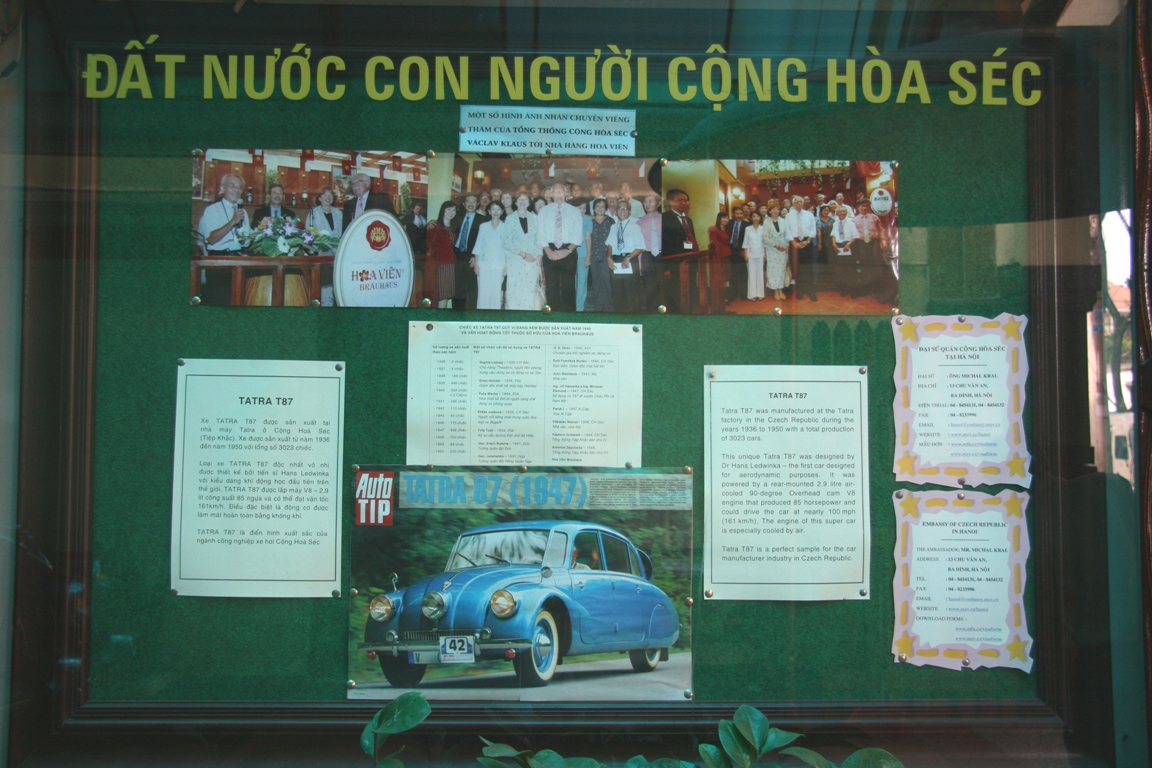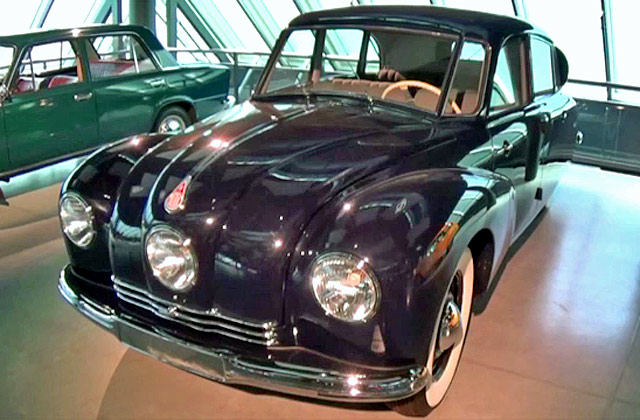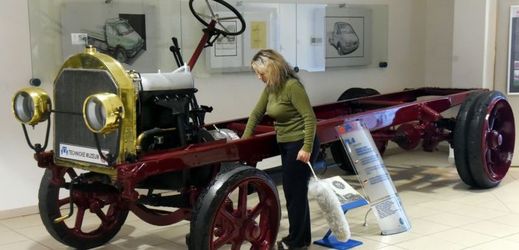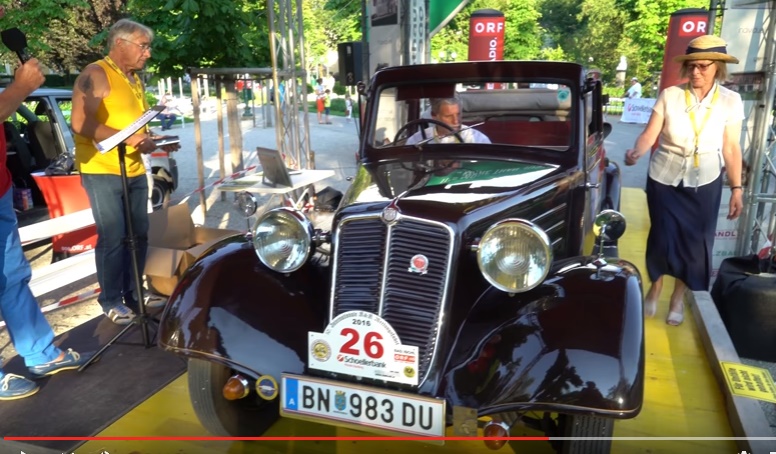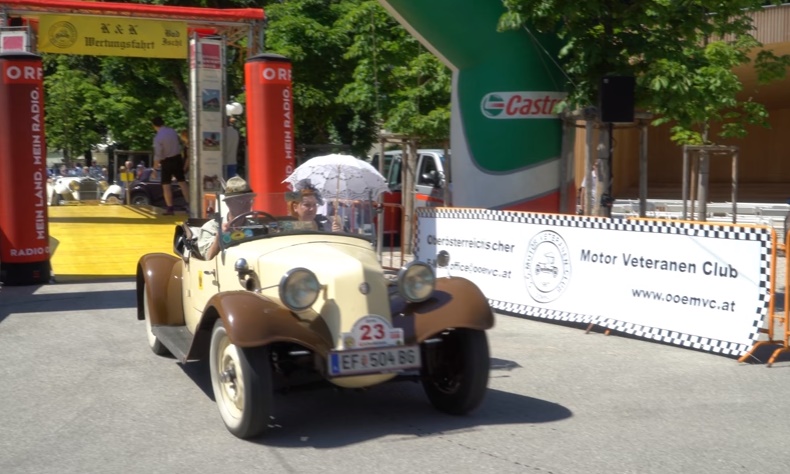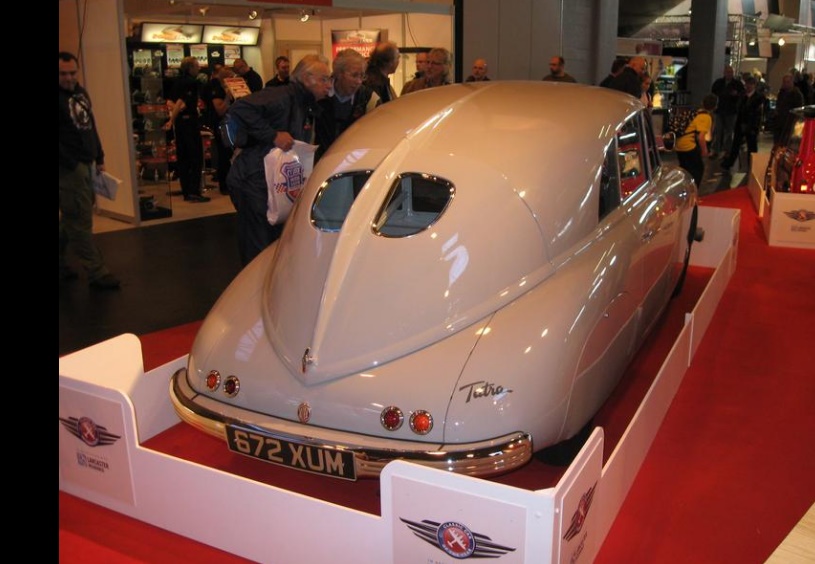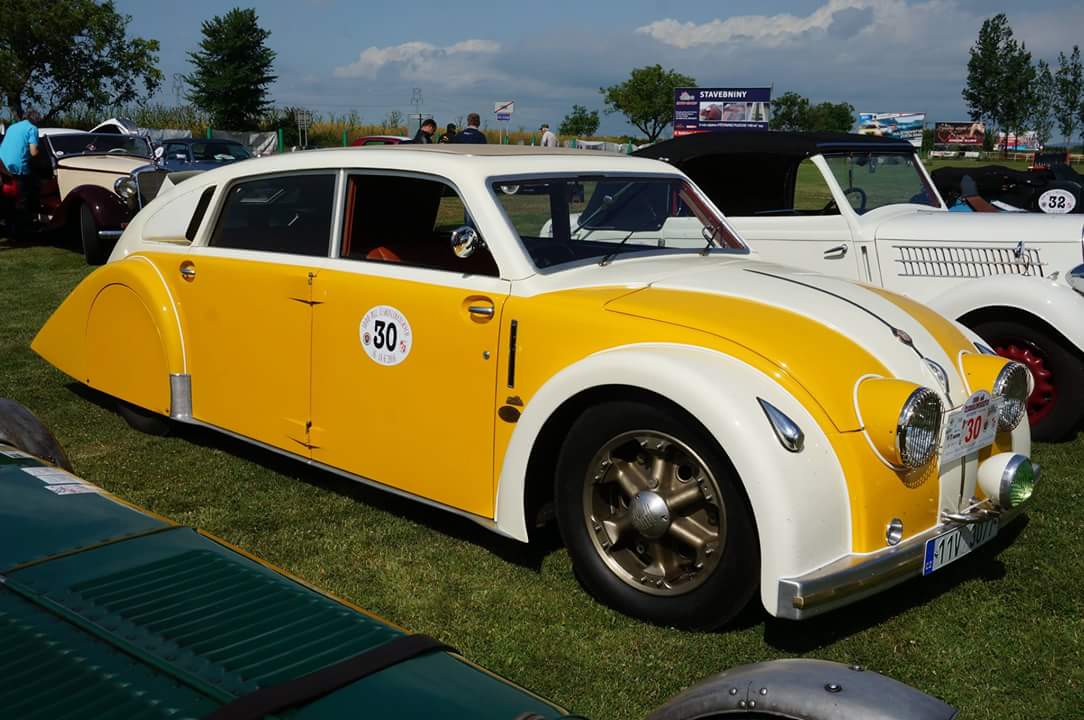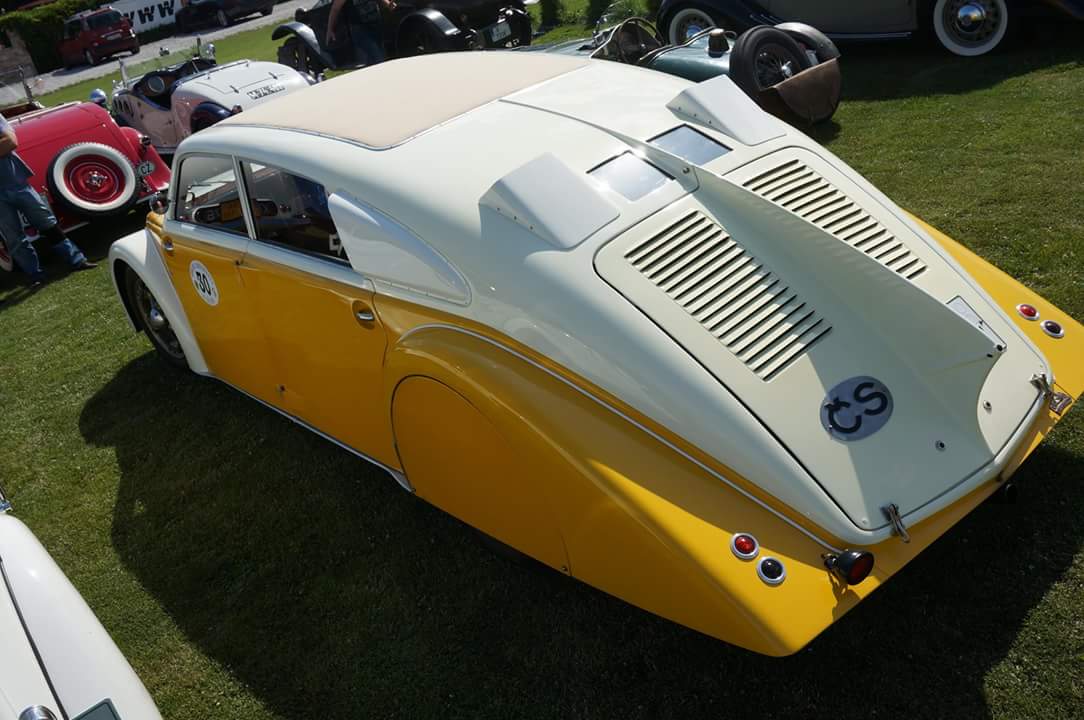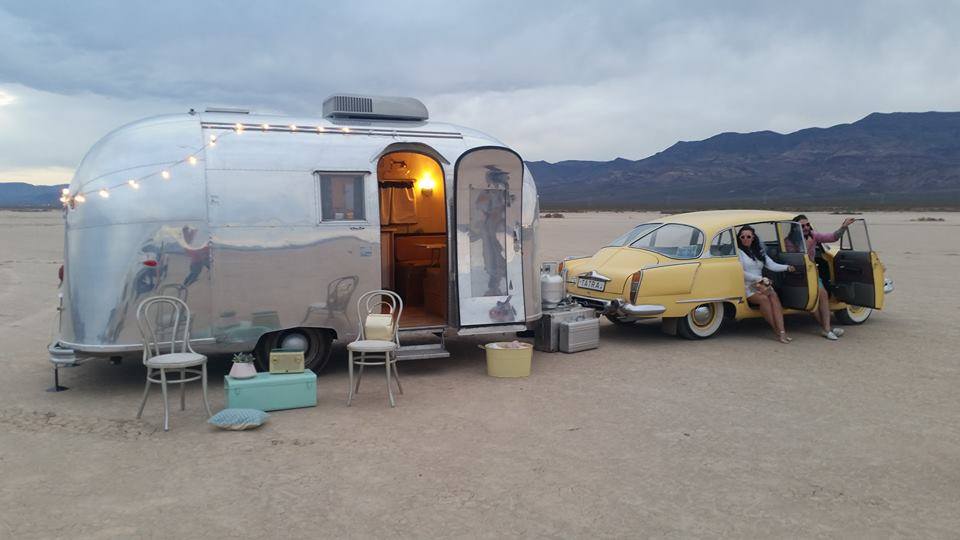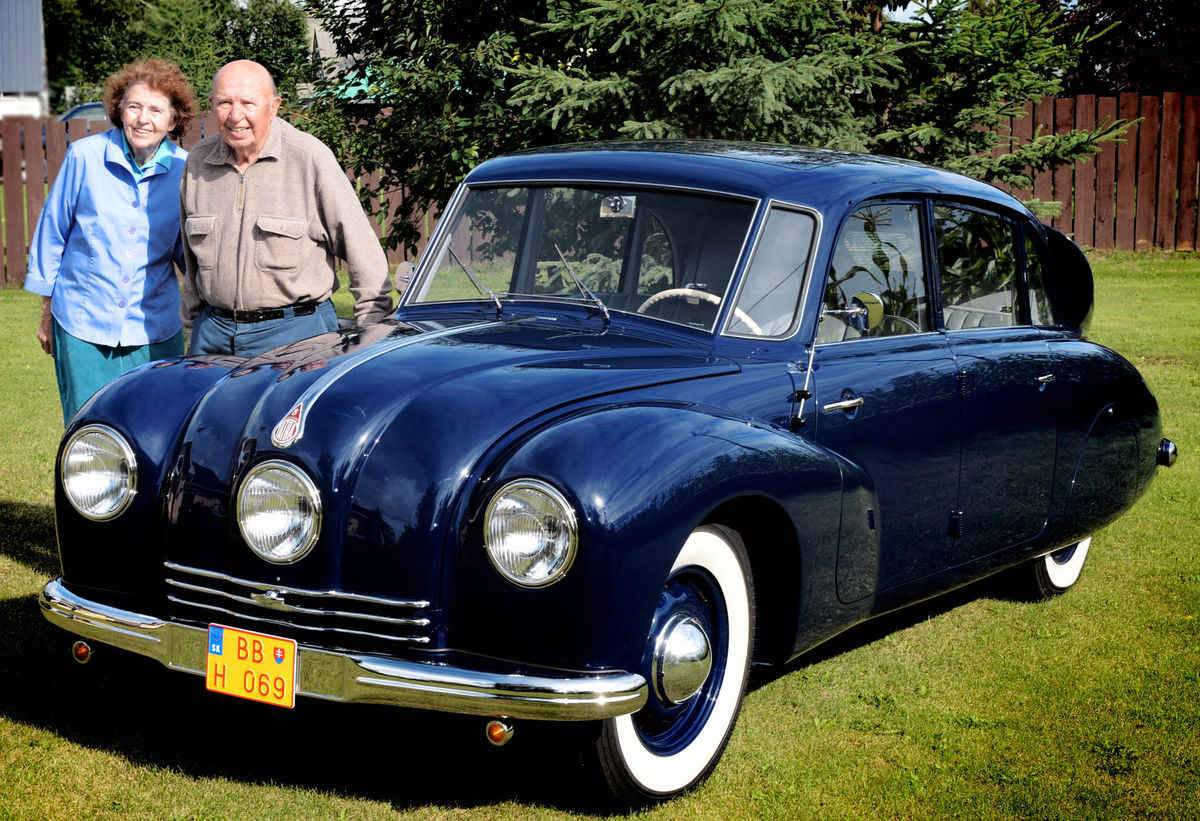
FAIRBANKS – The Golden Days Parade this year features two Czechoslovakian imports that both traveled a long way to be here — Paul Gavora and his newly-renovated Tatra 87.
Much of the information here is courtesy of the Gavora family.
Paul Gavora, of course, is a well-known Fairbanksan. He was born in the small village of Brezova in western Slovakia in 1931. At the age of 16, he was forced to leave his home and family after the Soviets installed a puppet regime in Czechoslovakia after the war. He went first to Austria, then to Germany, and finally to America on a United Nations boat for war refugees.
In Colorado, he met his bride-to-be Donna Tighe and in 1958, they made their way to Fairbanks.
The Tatra 87 is also from Czechoslovakia, named after the mountain range that forms the border between Slovakia and Poland. It was built in 1947 by Tatra, one of the oldest car manufacturers in the world. Tatra has been producing cars and trucks since 1897.
This Tatra 87 originated in central Europe. The Tatra, a luxury five-seat sedan, was called the “Nazi killer” and the “Czech secret weapon” during World War II because it was so powerful and aerodynamic that German soldiers had a tendency to kill themselves in it speeding around occupied Czechoslovakia. It could reach speeds of nearly 100 mph.
Even today, nearly 70 years after it was manufactured, the Tatra 87 is a unique automobile. It is streamlined, based upon the design of the Tatra 77, the first car designed for aerodynamic purposes.
The car has three headlights. Its sleek, air-slicing curves are highlighted by a large rear fin. That fin helps divide the air pressure on both sides of the car, a technique used in later aircraft, according to Wikipedia.
Combine that design with a rear-mounted, air-cooled overhead cam V-8 engine, and you have a truly unique car that looks like a zeppelin and drives like a speedboat.
Design elements of this car were copied by later car manufacturers, including Ferdinand Porsch. He was sued by Tatra for his design of the Volkswagen Beetle.
This particular car was discovered about 25 years ago by Paul Gavora’s brother Svetozar. He acquired it as an undriveable, rusting hulk.
Sveto was determined to restore the car himself and he tinkered with it for years. Fifteen years ago, Paul Gavora came upon the vehicle, lying in pieces in Sveto’s garage in Slovakia.
It took years, but Paul finally convinced his brother to sell the car to him. Then Paul and his nephew Martin Gavora had the car shipped to the original Tatra headquarters in the Czech Republic to be restored.
The result is a gleaming blue, rare antique car with all its original parts, including the original V-8 engine.
From the Czech Republic, the newly-restored Tatra traveled by truck to Antwerp Belgium. From there, it was placed in a shipping container and made the long trip across the Atlantic, through the Panama Canal and up the West Coast to Seattle. There, Paul’s son Matthew Gavora put the car on a trailer and towed it up to Fairbanks.
Other Tatra 87s are on display in museums and private collections all over the world. But Fairbanksans can see the local Tatra 87 in the Golden Days Parade on Saturday, driven by owners Paul and Donna Gavora.
It’s a spectacular way to celebrate the end of a very long journey.
By Greg ZylaMore Content Now
Q: Hello Greg and I enjoy your articles. Im wondering if you can give me some information on the T-600 Tatraplan automobile. I remember many years ago I saw an article I think you did on this car, but I have misplaced it. I also know the name Tataplan is really foreign to most car fans, but it was a car I do remember as I am retired now. My friend once had a 1947 Tatraplan, and it would be interesting to see what info you can further provide.
John L., retired and happy at age 84 in Illinois.
A: John thanks much for reading my columns and yes, I did do an article on the Tatraplan about eight years ago that appeared in Auto Roundup Magazine. I explained that the only time I ever heard of a Tatraplan car came thanks to my good friend, and one of the real legends of drag racing namely the late Jack Kulp. Kulp built and raced drag cars in the early days of dragster and gasser competition. Kulp especially loved running foreign cars like Simcas and Triumphs, sometimes to the chagrin of the racing associations.
Kulp informed me he would have loved to run a Czechoslovakian-built Tatraplan, but he never really had access to one that he could turn into an AA/Gas Supercharged drag strip terror.
To your question, the Tatraplan cars were assembled by the Tatra car company from 1946 to 1952. The predecessor of the T-600 was a model 107, so your friends 1947 model received either the nomenclature of 107 or the newer T-600. The car was a result of a government sponsored, centralized economic communist plan in Czechoslovakia.
The Tatraplans were streamlined full-size family cars that came with a 1952cc inline horizontally opposed flat four-cylinder air-cooled engine placed between the rear axles. The body had a coefficient aerodynamic drag of 0.32, which was great for that era and the main reason Jack Kulp wanted one to race. The wheelbase was 110-inches.
Overall, some 6,432 T-600s were sold from 1947 through 1952, but in late 1951, the Czech Department of Defense, which controlled all production of cars and trucks, informed Tatra they would now build trucks and that all cars would be built under the Skoda brand, the latter one two other government run car companies in the country at the time. The third car company in the Czech Republic was Praga.
In 1954, however, Tatra re-joined car building with a large passenger car with an air cooled V8 engine and transaxle. The V8 T603-engine had previously been developed and tested on the race track in Tatra experimental and race cars. It was used in the Tatra-603, and went on sale in 1955 and remained in production until 1975. In its 18 years of sales, a total of 20,422 T-603s were built.
Following my article years ago, I also received a nice letter from a gentleman in Australia named Craig who pointed out some very interesting facts about the 1947 Tatraplan models. As he was rebuilding a 1950 model at the time, he noted that the 1947 Tatraplan could be a model 107 or a T-600.
Craig explained the differences noting that the T-600 was essentially the same vehicle as the 107 but featured a vertically mounted fan whereas the 107 had a horizontally mounted fan and just one carburetor instead of two on the T-600. Craig also has a 603 Tatra with the air cooled and rear mounted V8 and we thank him for his input.
Today, Tatra is still in business and ranks among the oldest car and truck manufacturers in the world with more than 116-years of continuous activity. Tatra still impacts the auto and truck industry in the Czech Republic and abroad.
In ending, it is also very notable that since March of 2013, the Tatra Trucks Company is now owned by Czech shareholders, a big change in the philosophy of free enterprise.
Thanks for your letter John.
Greg Zyla writes weekly for More Content Now, BestRide.com and other Gatehouse Media publications. He welcomes reader questions on old cars, auto nostalgia and old-time motorsports at 303 Roosevelt St., Sayre, Pennsylvania 18840 or at greg@gregzyla.com.
By Greg ZylaMore Content Now
Q: Hello Greg and I enjoy your articles. Im wondering if you can give me some information on the T-600 Tatraplan automobile. I remember many years ago I saw an article I think you did on this car, but I have misplaced it. I also know the name Tataplan is really foreign to most car fans, but it was a car I do remember as I am retired now. My friend once had a 1947 Tatraplan, and it would be interesting to see what info you can further provide.
John L., retired and happy at age 84 in Illinois.
A: John thanks much for reading my columns and yes, I did do an article on the Tatraplan about eight years ago that appeared in Auto Roundup Magazine. I explained that the only time I ever heard of a Tatraplan car came thanks to my good friend, and one of the real legends of drag racing namely the late Jack Kulp. Kulp built and raced drag cars in the early days of dragster and gasser competition. Kulp especially loved running foreign cars like Simcas and Triumphs, sometimes to the chagrin of the racing associations.
Kulp informed me he would have loved to run a Czechoslovakian-built Tatraplan, but he never really had access to one that he could turn into an AA/Gas Supercharged drag strip terror.
To your question, the Tatraplan cars were assembled by the Tatra car company from 1946 to 1952. The predecessor of the T-600 was a model 107, so your friends 1947 model received either the nomenclature of 107 or the newer T-600. The car was a result of a government sponsored, centralized economic communist plan in Czechoslovakia.
The Tatraplans were streamlined full-size family cars that came with a 1952cc inline horizontally opposed flat four-cylinder air-cooled engine placed between the rear axles. The body had a coefficient aerodynamic drag of 0.32, which was great for that era and the main reason Jack Kulp wanted one to race. The wheelbase was 110-inches.
Overall, some 6,432 T-600s were sold from 1947 through 1952, but in late 1951, the Czech Department of Defense, which controlled all production of cars and trucks, informed Tatra they would now build trucks and that all cars would be built under the Skoda brand, the latter one two other government run car companies in the country at the time. The third car company in the Czech Republic was Praga.
In 1954, however, Tatra re-joined car building with a large passenger car with an air cooled V8 engine and transaxle. The V8 T603-engine had previously been developed and tested on the race track in Tatra experimental and race cars. It was used in the Tatra-603, and went on sale in 1955 and remained in production until 1975. In its 18 years of sales, a total of 20,422 T-603s were built.
Following my article years ago, I also received a nice letter from a gentleman in Australia named Craig who pointed out some very interesting facts about the 1947 Tatraplan models. As he was rebuilding a 1950 model at the time, he noted that the 1947 Tatraplan could be a model 107 or a T-600.
Craig explained the differences noting that the T-600 was essentially the same vehicle as the 107 but featured a vertically mounted fan whereas the 107 had a horizontally mounted fan and just one carburetor instead of two on the T-600. Craig also has a 603 Tatra with the air cooled and rear mounted V8 and we thank him for his input.
Today, Tatra is still in business and ranks among the oldest car and truck manufacturers in the world with more than 116-years of continuous activity. Tatra still impacts the auto and truck industry in the Czech Republic and abroad.
In ending, it is also very notable that since March of 2013, the Tatra Trucks Company is now owned by Czech shareholders, a big change in the philosophy of free enterprise.
Thanks for your letter John.
Greg Zyla writes weekly for More Content Now, BestRide.com and other Gatehouse Media publications. He welcomes reader questions on old cars, auto nostalgia and old-time motorsports at 303 Roosevelt St., Sayre, Pennsylvania 18840 or at greg@gregzyla.com.
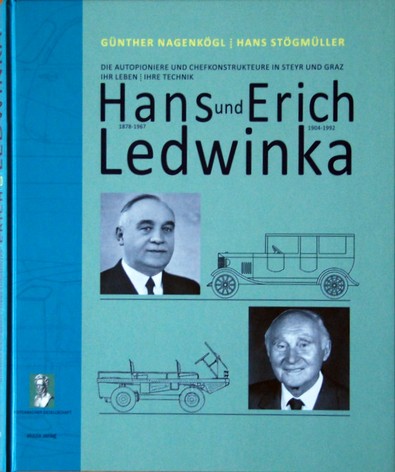
Die Autopioniere Hans und Erich Ledwinka, Ihr Leben, ihre Technik
Authors: Günther Nagenkögl und Hans Stögmüller
320 Pages
23 x 27,51 cm
language: German
Price € 29,90 (second edition will be slightly more expensive)
ISBN 978-3-9503964-3-0
Die Autopioniere Hans und Erich Ledwinka, Ihr Leben, ihre Technik
Authors:
Günther Nagenkögl und Hans Stögmüller
320 Pages
23 x 27,51 cm
Price € 29,90 (second edition will be slighly higher)
ISBN 978-3-9503964-3-0
Book impression: http://www.akaziaverlag.at/buecher-details/items/die-autopioniere-hans-und-erich-ledwinka-ihr-leben-ihre-technik.html
Regrettably, the book was published in very low numbers and has been sold out of several months. You are lucky if you have one! Due to a high demand, the publisher, Akazia Verlag, is considering a second print but want to play safe. If you want to order a second edition book, please order it at the publisher!
You can contact:
Publisher: Akazia Verlag
Grüner Hang 2, A-4293 Gutau, Austria
Contactperson: Mrs Regina David
Tel.(Austria): 0650 / 451 51 52
Tel. (From abroad): 0043/650 / 451 51 52
Mail: office@akaziaverlag.at
Die Autopioniere Hans und Erich Ledwinka, Ihr Leben, ihre Technik
Autor/in:
Günther Nagenkögl und Hans Stögmüller
320 Seiten
23 x 27,51 cm
Preis € 29,90
ISBN 978-3-9503964-3-0Vielen Dank für Ihr Interesse an diesem Buch!
Die Auflage ist leider komplett vergriffen. Derzeit keine zweite Auflage geplant. Das Verlag koennen Sie hilfen durch eine Bestellung direkt am Verlag zu machen.
Verlag : Akazia Verlag
Grüner Hang 2, A-4293 Gutau
Kontaktperson: Frau Regina David
Tel.- Inland : 0650 / 451 51 52
Tel.-Ausland: 0043/650 / 451 51 52
Mail: office@akaziaverlag.at
Hineinlesen: http://www.akaziaverlag.at/buecher-details/items/die-autopioniere-hans-und-erich-ledwinka-ihr-leben-ihre-technik.html
Zwei Autoren schrieben ein Buch über die beiden Autopioniere Hans Ledwinka (1878-1967) und dessen Sohn Erich (1904-1992), die in Steyr, Nesselsdorf/Kopřivnice und Graz ihre Meisterleistungen vollbrachten. Hans Ledwinka war für das erste in Steyr produzierte Auto verantwortlich und leitete dann das Tatra-Werk in Mähren (Tschechien) bis 1945. Sein Sohn Erich konstruierte nach beruflichen Einsätzen in Nesselsdorf, Berlin, München und Steyr in Graz den Steyr-Puch Haflinger und den Steyr-Puch Pinzgauer.
„Den Anstoß, das Buch zu schreiben, gab die Schenkung des schriftlichen Nachlasses der beiden Konstrukteure durch Hans Ledwinka an das Stadtarchiv Steyr“, sagt der Journalist Hans Stögmüller, der gemeinsam mit dem Techniker Ing. Günther Nagenkögl Autor des Bandes ist. Der promovierte Chemiker Hans Ledwinka lebt in St. Ulrich bei Steyr und ist der Sohn Erichs und der Enkel von Hans Ledwinka.
Mehr als zwanzig Schachteln voll mit schriftlichen Unterlagen, Plänen und Fotos umfasst der Nachlass Ledwinka. Er wurde von Mitgliedern der Historiengruppe der Redtenbacher-Gesellschaft Steyr geordnet und dem Steyrer Stadtarchiv übergeben.
Das Buch gibt einen perfekten Überblick über Leben und Schaffen von Ledwinka Vater und Sohn. Hans Ledwinka, der am 14. Februar 1878 in Klosterneuburg bei Wien geboren wurde, besuchte nach einer Schlosserlehre die Werkmeisterschule in Wien und ging dann als Konstrukteur nach Nesselsdorf in Mähren. Er wirkte bereits beim ersten Auto mit, der als „Präsident“ 1898 vorgestellt wurde.
Nach einer kurzen Zeit bei einem Wiener Dampfwagen-Erzeuger war er ab 1906 als Leiter der Abteilung Automobilbau in Nesselsdorf beschäftigt. Dann kam 1916 der Ruf nach Steyr, wo er die Automobilfertigung aufbaute und den ersten Wagen, den Typ Steyr II, entwickelte. Weitere Typen folgten, doch Ledwinka übersiedelte 1923 wieder nach Nesselsdorf, wo er Werkschef wurde.
Es folgte eine Vielzahl von Personenwagen, darunter die epochale Entwicklung des Tatra 11 mit luftgekühltem Zweizylinder-Motor, Zentralrohrrahmen und Pendelachse, aber auch Stromlinienautos, Lastwagen, Eisenbahnfahrzeuge und Flugzeuge. 1945 wurde Ledwinka verhaftet und wegen Staatsverrats sechs Jahre einsperrt. Anschließend lebte er in München.
Sein Sohn Erich kam 1930 nach dem Maschinenbaustudium an der TH Wien zu seinem Vater nach Nesselsdorf, wo er an der Entwicklung einiger Autos mitarbeitete. 1937 bis 1940 war er beim Flugzeugbauer Bücker in Berlin tätig, um dann wieder zu Tatra zurückzukehren. Ihm gelang rechtzeitig die Flucht vor den Sowjets. Nach freiberuflicher Tätigkeit in Bayern kam er 1950 zu Steyr-Daimler-Puch nach Steyr. Er wurde dafür auserkoren, einen Kleinwagen zu entwickeln, aus dem nach mehreren Varianten der Steyr-Puch 500 mit Fiat-Karosserie entstand.
Anschließend war Erich Ledwinka Technischer Direktor in Graz, wo er für den Haflinger und den Pinzgauer verantwortlich zeichnete. Auch an der Entwicklung des Geländewagens Puch G war er beteiligt, der heute noch in Graz als Mercedes G erzeugt wird. Erich Ledwinka promovierte an der TU Graz zum Doktor der Technischen Wissenschaften.
Hans Ledwinka wurde mit dem Dr. h. c. geehrt und wie auch sein Sohn mit vielen Ehrungen überschüttet. Vorläufiger Höhepunkt war 2007 die Aufnahme in die Ruhmesgalerie (European Automotive Hall of Fame) in der Eingangshalle des Genfer Autosalons. Neben Ferdinand und Ferry Porsche ist Hans Ledwinka der dritte Österreicher in der illustren Runde von Autokonstrukteuren.
Die Autoren:
Günther Nagenkögl, geb. 1946 in Steyr. Von 165 – 1970 bei Steyr-Daimler-Puch AG als Motorenkonstrukteur. Ab Herbst 1985 Gruppenleiter „Neue Motorenprojekte“. 1990 Eintritt in das Motorenforschungsinstitut AVL-List GmbH in Graz. Leitung des Konstruktionsbüros für Nutzfahrzeugmotoren am Standort Steyr. Ab 2009 im Ruhestand. Selbständiger Konsulent für Dieselmotorenkonstruktion.
Hans Stögmüller, geboren 1949 in Steyr, war Redakteur einer oberösterreichischen Tageszeitung. Er beschäftigt sich seit langer Zeit intensiv mit der Geschichte der Eisenstadt Steyr und ihrer Umgebung. Er verfasste die Bücher »Wehrgraben. Führer durch Geschichte und Arbeitswelt« (1987) und zusammen mit Gerhard Sperl und Werner Tippelt den Kulturführer »Österreichische Eisenstraße« (1992). 2010 erschien sein Buch »Josef Werndl und die Waffenfabrik in Steyr«. Als Mitglied des Vereins »Freunde der Geschichte der Stadt Steyr und der Eisenwurzen« ist er auch regelmäßig Autor für das Jahrbuch des Stadtarchivs Steyr.
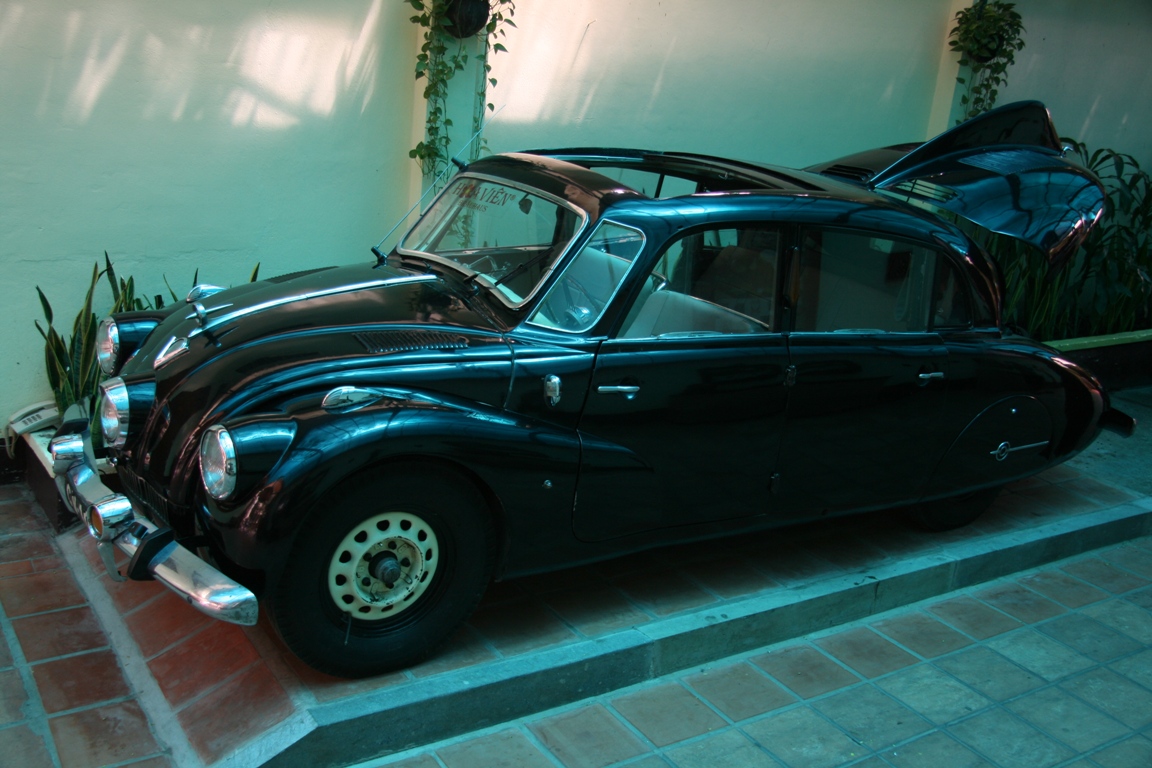
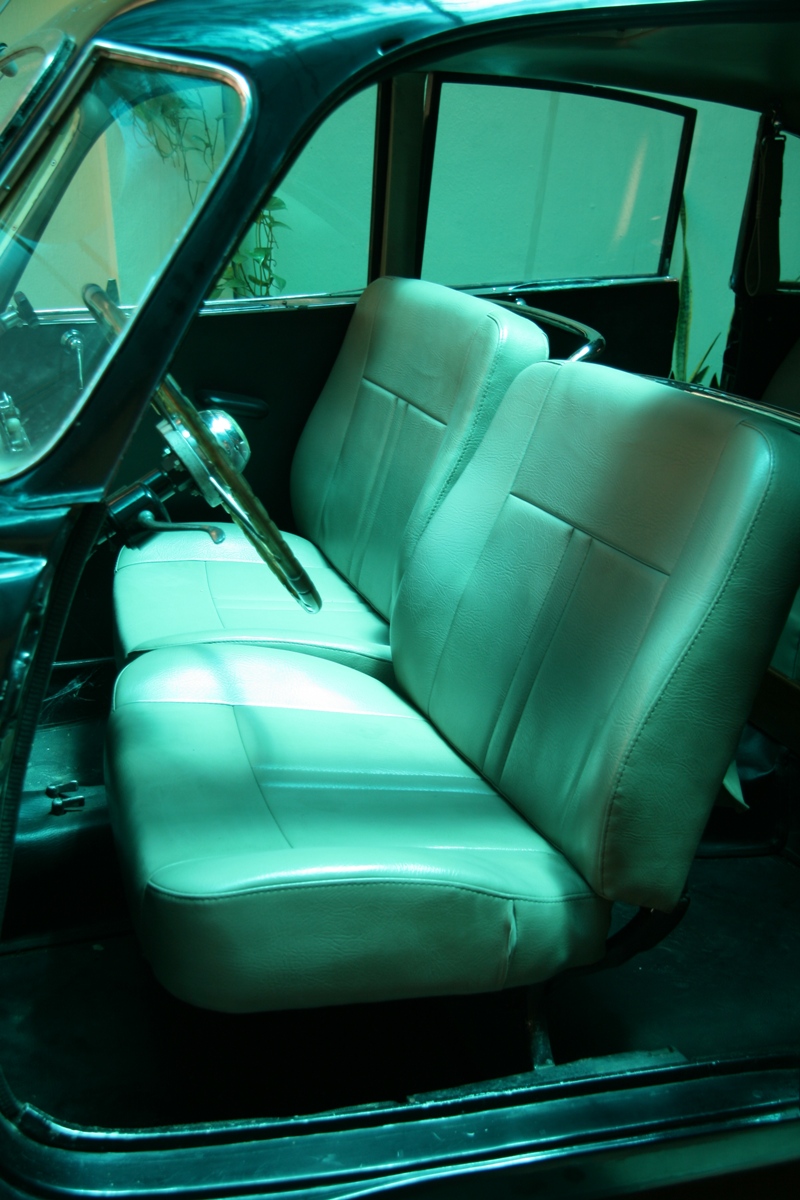
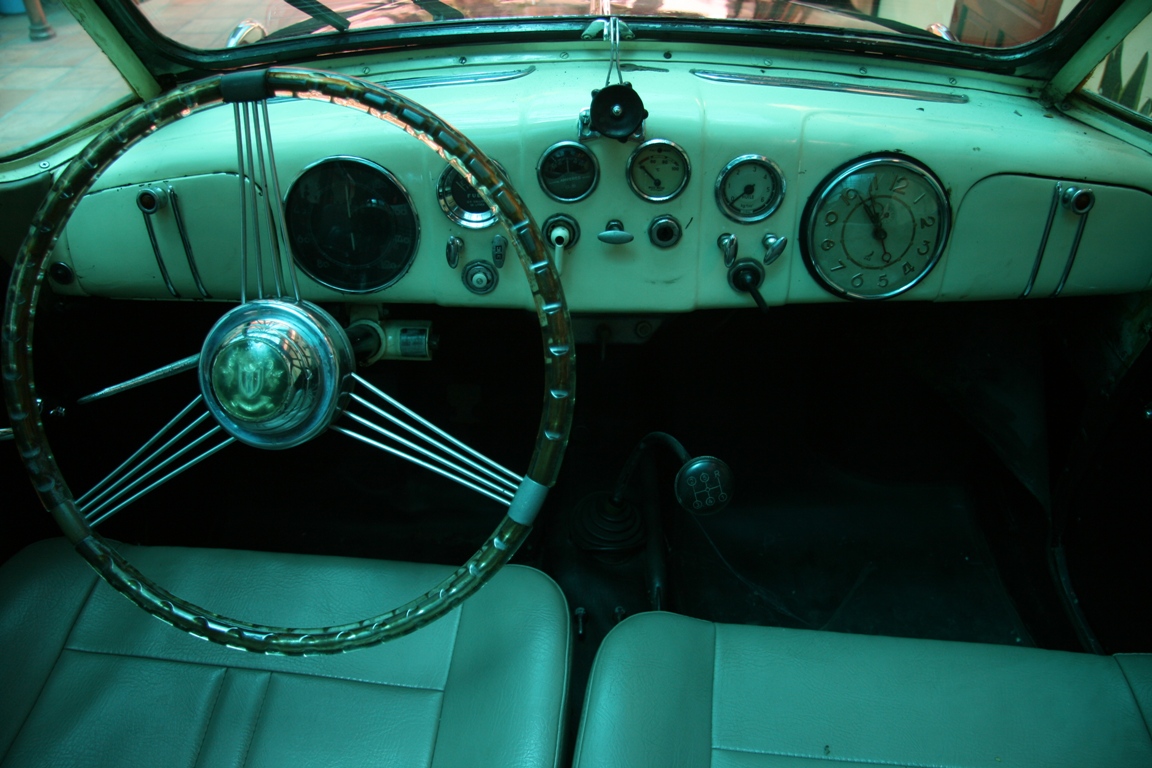

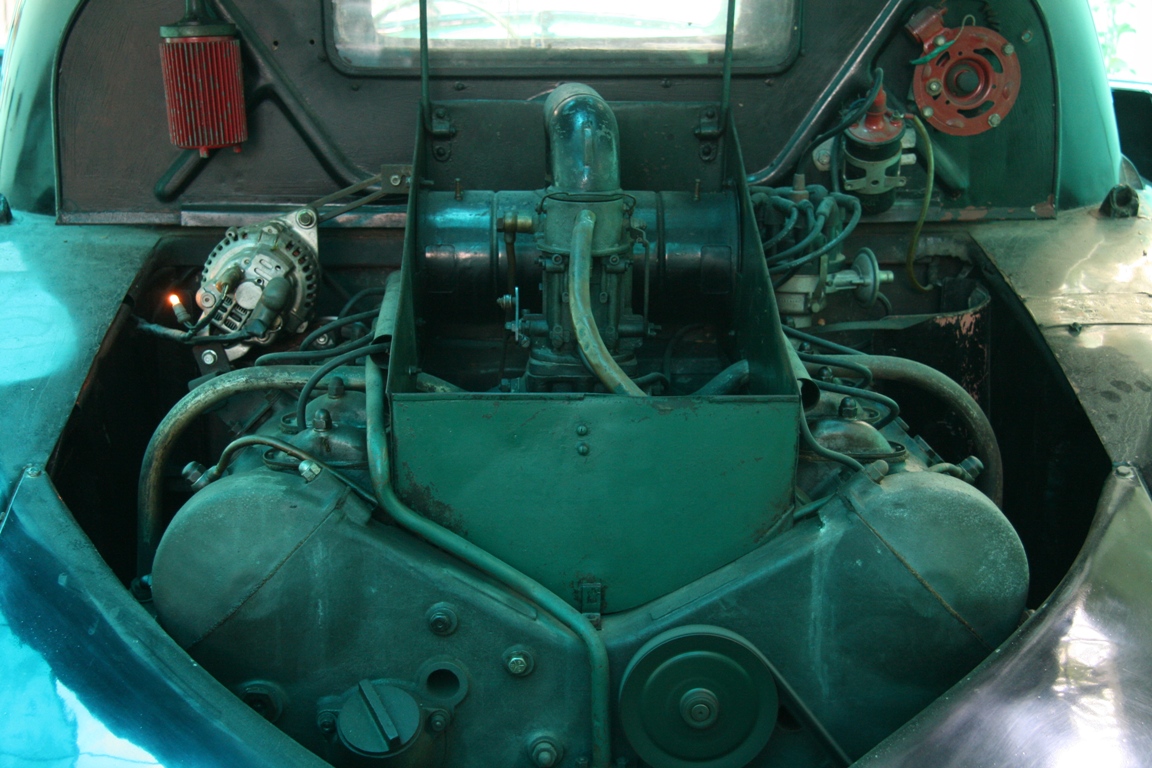
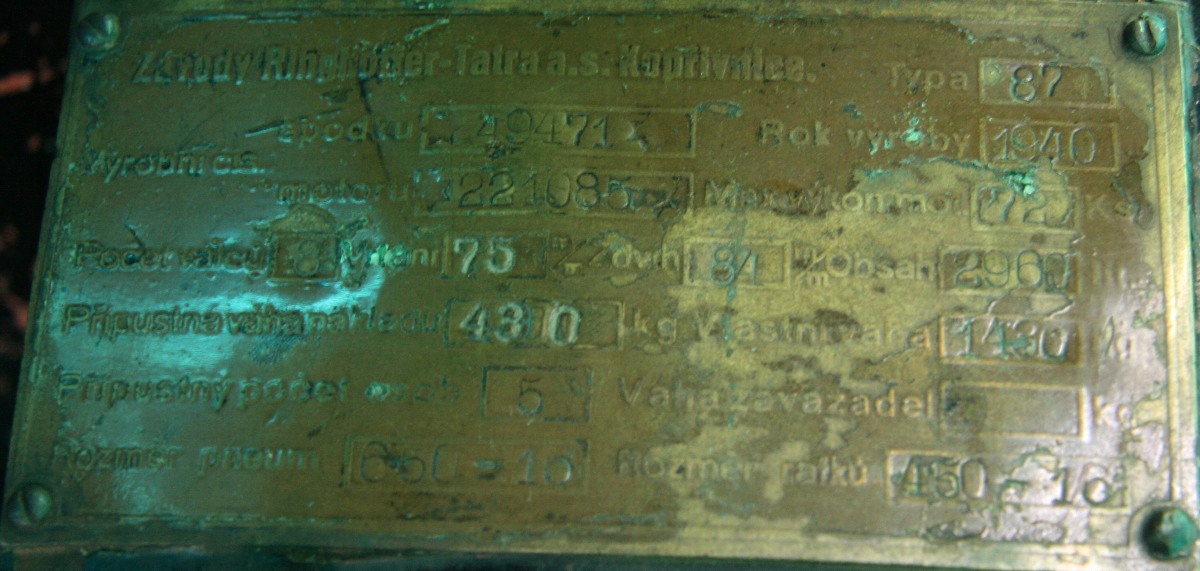 The label (name-plate) originally attached to the engine compartment.
The label (name-plate) originally attached to the engine compartment.